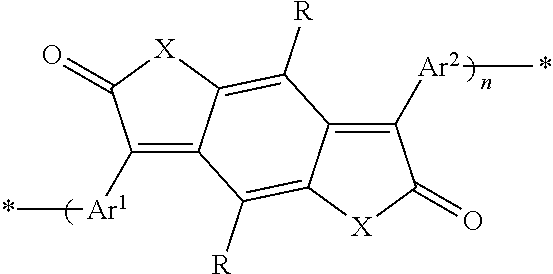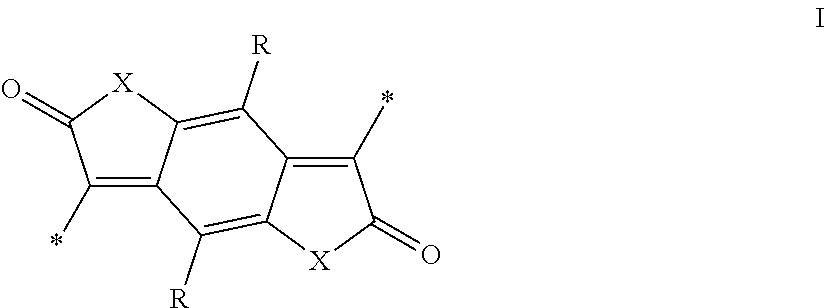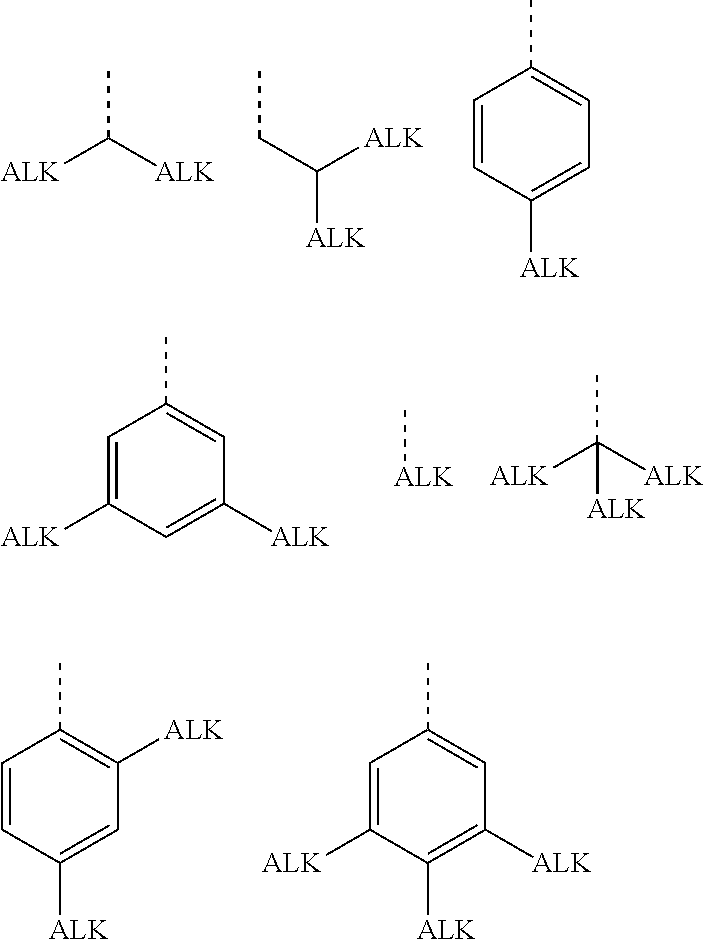Semiconducting polymers
a technology of semiconductors and polymers, applied in the field of semiconductors, can solve the problems of not being suggested to use such compounds, and achieve the effect of improving the efficiency of the system
- Summary
- Abstract
- Description
- Claims
- Application Information
AI Technical Summary
Benefits of technology
Problems solved by technology
Method used
Image
Examples
example 1
2-(4-Bromo-phenyl)-N-{4-[2-(4-bromo-phenyl)-2-hydroxy-acetylamino]-phenyl}-2-hydroxy-acetamide (1.1)
[0184]
[0185]In a 250 cm3 flask fitted with a consender and a reverse Dean-Stark apparatus, the (4-bromo-phenyl)-hydroxy-acetic acid (25.00 g, 108.2 mmol) and 1,4-phenylenediamine (3.900 g, 36.07 mmol) are dissolved in chlorobenzene (100 cm3). The reaction mixture is heated to 132° C. while the generated water is distilled off the using the reverse Dean-Stark apparatus. After 21 hours, the reaction mixture is cooled down, the precipitate is filtered off and washed with methanol to yield the product (18.21 g, Yield: 95%). NMR (1H, 300 MHz, CDCl3): δ 9.90 (br, 2H); 7.59 (s, 4H); 7.56 (d, J=8.5 Hz, 4H); 7.45 (d, J=8.5 Hz, 4H); 6.53 (d, J=4.7 Hz, 2H), 5.08 (d, J=4.7 Hz, 2H).
3,7-Bis-(4-bromo-phenyl)-5,7-dihydro-1H,3H-pyrrolo[2,3-f]indole-2,6-dione (1.2)
[0186]
[0187]2-(4-Bromo-phenyl)-N-{4-[2-(4-bromo-phenyl)-2-hydroxy-acetylamino]-phenyl}-2-hydroxy-acetamide (18.00 g, 33.70 mmol) (1.1) is ad...
example 2
3,7-Bis-(4-bromo-phenyl)-1,5-bis-(2-hexyl-decyl)-1H,5H-pyrrolo[2,3-f]indole-2,6-dione (2.1)
[0194]
[0195]3,7-Bis-(4-bromo-phenyl)-1H,5H-pyrrolo[2,3-f]indole-2,6-dione (1.500 g, 3.023 mmol) (1.3) is dissolved into anhydrous dimethylformamide (60 cm3) and then potassium carbonate (4.178 g, 30.23 mmol) and 7-bromomethyl-pentadecane (2.308 g, 7.558 mmol) are added. The resulting mixture is heated to 90° C. for 21 hours before been cooling down, poured into methanol (400 cm3), filtered and washed with water (200 cm3) to recover the pure product (1.525 g, Yield: 53%). NMR (1H, 300 MHz, CDCl3): δ 7.61 (d, J=8.7 Hz, 4H), 7.57 (d, J=8.6 Hz, 4H), 6.29 (s, 2H), 3.50 (d, J=7.3 Hz, 4H), 1.76 (m, 2H), 1.28 (m, 48H), 0.86 (t, J=7.1 Hz, 12H)
Poly(2,6-[4,8-didodecyl-benzo{1,2-b;4,5-b′}dithiophene]-alt-[3,7-bis-{phenyl-4-ene}-1,5-(2-hexyl-decyl)-1H,5H-pyrrolo{2,3-f}indole-2,6-dione) (2.2)
[0196]
[0197]In a 25 cm3 round bottom flask, 3,7-bis-(4-bromo-phenyl)-1,5-(2-hexyl-decyl)-1H,5H-pyrrolo[2,3-f]indole-2...
example 3
3,7-Bis-(4-bromo-phenyl)-4,8-dioctyl-benzo[1,2-b;4,5-b′]difuran-2,6-dione (3.1)
[0198]
[0199]In a 100 cm3 flask fitted with a condenser and a reverse Dean-Stark apparatus, (4-bromo-phenyl)-hydroxy-acetic acid (6.043 g, 26.16 mmol) and 2,5-dioctyl-benzene-1,4-diol (Bao, Z.; Chan, W. K.; Yu, L. J. Am. Chem. Soc. 1995, 117, 12426-12435.) (3.500 g, 10.46 mmol) are dissolved in 1,2-dichlorochlorobenzene (35 cm3). The reaction mixture is heated to 200° C. and the generated water is distilled off the using a reverse Dean-Stark apparatus. After 2 hours stirring, the reaction mixture is cooled down and the solvent was removed in vacuo. (9.501 g, Crude yield: 125%). The crude 3,7-bis-(4-bromo-phenyl)-4,8-dioctyl-3,7-dihydro-benzo[1,2-b;4,5-b′]difuran-2,6-dione (7.500 g, 10.35 mmol) is dissolved into acetic acid (125 cm3) at 50° C. before adding chloranil (5.090 g, 20.70 mmol). After 16 hours stirring, the reaction mixture is cooled down and the resulting precipitate is filtered. The recovered s...
PUM
| Property | Measurement | Unit |
|---|---|---|
| Electrical conductor | aaaaa | aaaaa |
| Transport properties | aaaaa | aaaaa |
| Light | aaaaa | aaaaa |
Abstract
Description
Claims
Application Information
 Login to View More
Login to View More - R&D
- Intellectual Property
- Life Sciences
- Materials
- Tech Scout
- Unparalleled Data Quality
- Higher Quality Content
- 60% Fewer Hallucinations
Browse by: Latest US Patents, China's latest patents, Technical Efficacy Thesaurus, Application Domain, Technology Topic, Popular Technical Reports.
© 2025 PatSnap. All rights reserved.Legal|Privacy policy|Modern Slavery Act Transparency Statement|Sitemap|About US| Contact US: help@patsnap.com



